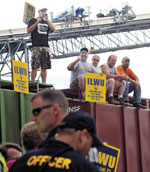
Showdown on West Coast Docks: The Battle of Longview
(November 2011).
click on photo for article
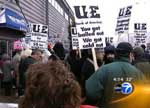
Chicago Plant Occupation Electrifies Labor
(December 2008).
click on photo for article
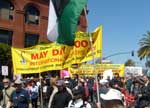
May Day Strike Against the War Shuts Down
U.S. West Coast Ports
(May 2008)
click on photo for article

December 2021
For
Workers Safety Committees – Democrats, NLRB No
Friends of Labor
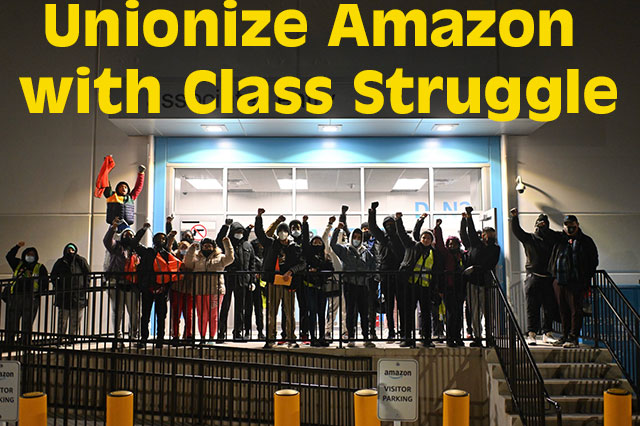
On the early morning of December 22, at the height of the Xmas rush, some 30 Amazon workers walked out at the DLN2 warehouse in Cicero, Illinois (above), along with others in nearby Gage Park. The walkout, organized by Amazonians United, demanded higher pay, longer break time and the conversion of temporary workers to permanent. (Photo: Paul Goyette / Twitter)
- Teamsters Launch Campaign
- Bessemer Gets a Re-vote
- Staten Island Re-files for Election
DECEMBER 28 – The fight to unionize the e-commerce giant monopoly Amazon, a crucial struggle for the workers movement, has heated up. In June, the powerful International Brotherhood of Teamsters (IBT) union resolved to carry out a coast-to-coast campaign to organize Amazon workers, starting with an effort at nine warehouses in Canada. Then in November the National Labor Relations Board (NLRB) threw out the results of the union recognition vote held last spring in Bessemer, Alabama because of Amazon’s dirty tricks and interference in the election. And on December 22 in New York City, the independent Amazon Labor Union (ALU) re-filed its petition with the NLRB for a union recognition vote at the JFK8 warehouse in Staten Island.
The burning need for unionization of Amazon was brought home on December 12 when tornadoes tore through an Amazon warehouse in Edwardsville, Illinois, killing six workers inside and injuring others. One worker who was killed had texted his girlfriend, “Amazon won’t let us leave.” At the same time, an Amazon driver was told that if she did not stay on the road and make deliveries, even as warning sirens blared, it would be considered a “refusal” to work and she would be fired! This was industrial murder. It is typical of Amazon’s brutal methods of exploitation in which workers are injured – often permanently – at a rate 80% higher than in other warehouses, where workers are maimed at the “normal” capitalist rate.
Amazon makes it very difficult to obtain insurance coverage and compensation for on-the-job injuries. An essential part of its model is to wear out and use up workers quickly, resulting in a rapid turnover (which makes union organizing very difficult). In NYC, at Hurricane Ida approached, the warehouse remained open, while workers travelling to and from the facility were threatened by widespread flooding. Amazon carries out minimal or no emergency preparedness. It should be required to have hardened underground safe rooms for tornados and hurricanes, and at every facility and dispatch location, there should be worker safety committees to enforce safety protocols and assert their power to stop production if working conditions are unsafe!
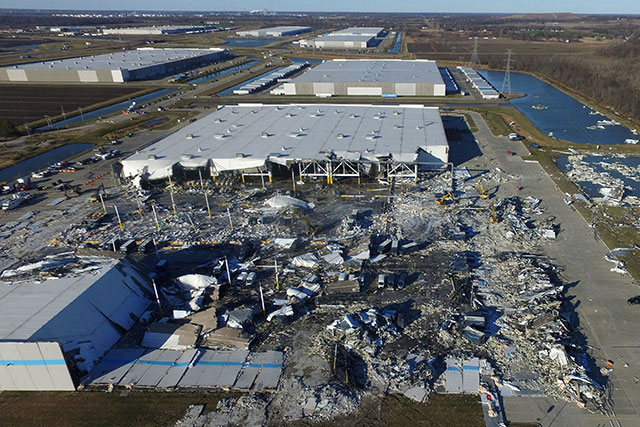
Six workers killed in Amazon warehouse hit by tornado in Illinois, December 10. (Photo: Drone Base / Reuters)
How can we do that? The tragedy in Edwardsville underlines the urgent need to unionize the entire Amazon empire. While demanding the most rigorous safety standards be adhered to, one can’t rely on Amazon or the NLRB, which is an agency of the bosses’ government. Nor will it be achieved by looking to the Democratic Party, which is a capitalist party, representing the owners of industry and commerce as much as, or even more than, the Republicans. As we have pointed out, in the 2020 election cycle Wall Street gave five times as much money to the Democrats as to Republican candidates, and in the case of Big Tech far more than that. Amazon gave 13 times as much to the phony “friend of labor” Democrats as to Trump and the Republicans.1
To unionize Amazon, it will be necessary to mobilize the power of the workers movement in sharp class struggle. The normal tactics of “business unionism,” based on collaboration with management, won’t cut it. To defeat the hard-nosed union-busters at Amazon will take strikes and walkouts, flying pickets, plant occupations – the kind of class-struggle methods that built the unions in the 1930s. Unionization must include everyone from pickers and drivers to airline pilots, nationally, and internationally. And it requires independence from the bosses’ government and parties, as we fight to build a class-struggle workers party that defends black people, women, immigrants and all the oppressed.
Solidarity is key. Unionizing Amazon will be more like a revolt of the working people than your run-of-the-mill piecemeal organizing campaign. It's a tall order and a hard fight, but we – the workers and oppressed – have the power. For all the automation at Amazon, without the workers, nothing will move.
Amazon: Union-Buster, Pandemic Profiteer, Industrial Murder Machine
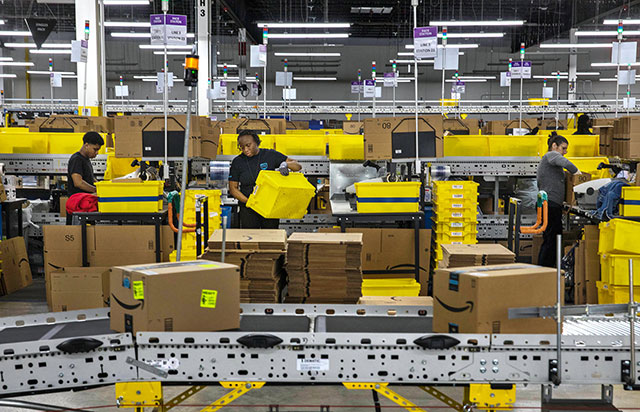
Amazon warehouses are built like a giant erector set that could easily collapse under pressure. JFK8 in Staten Island (above) is the size of 15 football fields. (Photo: Hiroko Masuike / The New York Times)
Amazon’s founder and executive chairman Jeff Bezos is a modern-day robber baron, using vicious anti-labor methods to carry out savage exploitation of Amazon’s 1.5 million employees worldwide, with 1 million in the U.S. Bezos has been a pandemic profiteer, with his net worth now at $208 billion, even after his divorce settlement has given his ex-wife a tidy fortune of $62 billion. In addition to its e-commerce monopoly (it controls almost 50% of the U.S. market), Amazon has many subsidiaries, including Whole Foods, the Washington Post, and Amazon Web Services, the world’s largest cloud computing platform, notable for its recent outages.
Initially mainly relying on UPS, FedEx and the U.S. Postal Service to make its deliveries, Amazon now delivers most of the products it sells (and the products of third-party vendors) with its own vast fleet of 60,000 trucks and vans, with 100,000 more on order, and its fleet of 80 large cargo aircraft. It is estimated that the company now makes 20% of the shipments in the U.S. That’s why a resolution at the June 2021 Teamsters convention referred to Amazon as an “existential threat” to the union, since with its low wages and poor working conditions it exerts a downward pressure on unionized trucking and delivery companies.
No Amazon facility in the U.S. is unionized, and while there are several unions at its European operations, only in Italy have they won a contract – by striking. In Germany, the Ver.di service workers union forced some concessions through repeated strikes. In spring 2020, French workers forced Amazon to provide safety measures against COVID at six warehouses. But in the U.S. and globally, Amazon was notorious for providing little or no safety protocols or PPE in the early stages of the pandemic. In November, it was fined $500,000 by California for failing to notify workers of outbreaks in its warehouses.
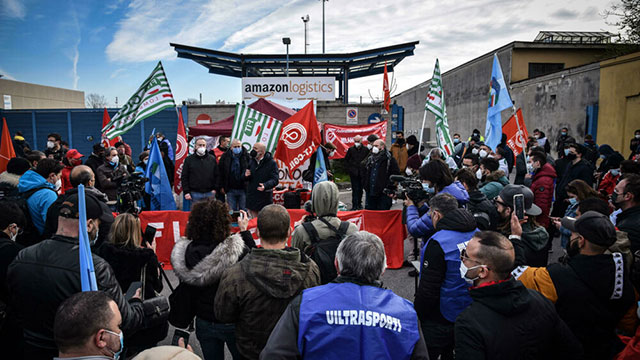
No Amazon facilities in North America have been unionized. In Europe, only in Italy have unions won a contract. Above, Milan logistics center during first-ever national strike against Amazon, 22 March 2021. (Photo: ANSA)
Vice magazine (23 November 2020) detailed the company’s vast spy and surveillance network directed against union activity, including the hiring of the notorious Pinkerton detective agency. At its Global Security Operations Center, “intelligence analysts keep close tabs on how many warehouse workers attend union meetings.” Recently Amazon started to apply hi-tech methods to its hundreds of thousands of drivers, requiring them to submit to biometric monitoring, with “faceprinting” and video snooping on their every action (including yawning or getting out of the cab to relieve themselves) to ensure non-stop labor. It also tells delivery drivers to turn off safety apps monitoring vehicle speed in order to meet production quotas.
Amazon workers have difficulty getting disability pay and COVID leaves under the company’s automated “Human Resources by App” system, which is subject to glitches and provides no accountability. The Boston Globe (24 July) reported how workers injured on the job got the run-around in getting workers’ compensation to cover medical treatment: “Employees alleged that the trillion-dollar behemoth and the company it uses to handle the cases made accessing the payments and health care due to them under state law confusing and difficult, leaving many languishing for weeks or months with only minimal benefits.”
Lessons of Bessemer
On April 9, the National Labor Relations Board announced results of the vote at the union election at Amazon’s BHM1 warehouse in Bessemer, Alabama. The vote was 1,798 against to 738 for the union, with some 500 ballots contested, mostly by the company. The result was a victory for Amazon, which had waged a vicious anti-union campaign, and a bitter defeat for the RWDSU (Retail, Warehouse and Department Store Union). The RWDSU blamed the defeat on unfair labor laws and the illegal activities of Amazon, as well as “legal” tactics such as requiring workers to attend “captive audience” meetings with anti-union consultants (paid $3,200 a day), threatening that bringing in a union would mean a loss of benefits, and implying that it could shut down the warehouse if workers voted to unionize, as it did at a warehouse in Chicago where workers had carried out protests.
On November 29, the NLRB ruled in favor of the RWDSU, nullifying the results of the election and allowing a re-vote, for which a date has not been set. The union has maintained a base of supporters in the Bessemer facility and recently posted on Facebook (BAmazonUnion, 22 December) about how on November 28-29, two workers collapsed in the warehouse within six hours of each other. Both died. One worker had suffered a stroke while working, but his manager told him he could not leave, and that since he had no “unpaid time off” remaining, if he left he could be fired. After the deaths the company told workers to carry on working and not to talk about what had happened. At least four other workers have died at that warehouse this year.
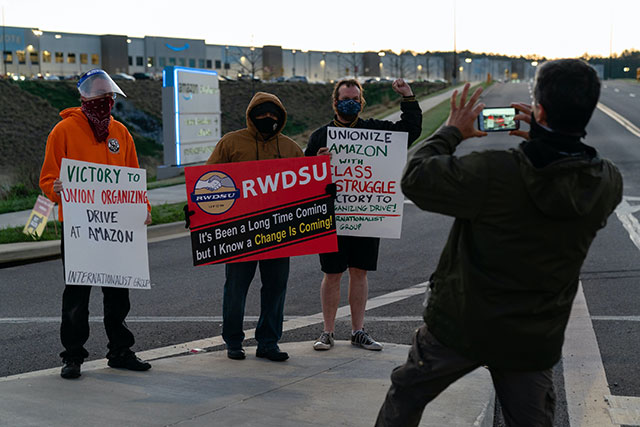
Trade-union supporters of the Internationalist Group during unionization campaign at BHM1 warehouse in Bessemer, Alabama, 27 March 2021. (Photo: Elijah Nouvelage / Getty Images)
The Bessemer campaign, carried out by a mainly black workforce in the deep South, if successful would be the first union victory against Amazon in the U.S. As word of the campaign spread last spring, many Walmart workers, Whole Foods workers and unorganized workers around the country looked to the Bessemer struggle as their own. In the wake of the defeat in that election, now annulled, there were many post-mortems from the left, and other unions, mostly focusing on tactical issues. For example, that the RWDSU should not have proceeded with the vote after Amazon won a broad definition of warehouse employees to include seasonal and temporary workers; or that the union should have pushed for workers to wear pro-union buttons or otherwise go “public.” (The RWDSU said it didn’t do so because of Amazon’s history of firing pro-union workers.)
The campaign was also criticized for being too rushed – the vote was held less than a year after the warehouse was opened in March 2020. Workers in BHM1, many of whom had been active in the massive wave of protests against racist cop terror that summer, approached the RWDSU in July of that year. The union felt it had to act quickly and forge ahead because of the high turnover at Amazon warehouses. It was also criticized for relying on phone banking to convince workers to vote for the union instead of visiting them at home. The Internationalist objected that in response to Amazon’s harping about union dues, the RWDSU said workers wouldn’t have to pay because Alabama is a “right-to-work” state where requiring union membership is outlawed!
The real lesson of the Bessemer defeat is that it showed the limits of playing by the bosses’ rules. NLRB-supervised representation elections are so rigged in favor of the companies, and unions are so hamstrung by anti-labor laws, that it is extremely difficult, often next to impossible to win by going that route alone. A fighting union would have mobilized workers in action to demand a big wage increase, union safety committees, slowing down the breakneck line speed, etc. The RWDSU leaders wouldn’t do that, because like the rest of labor officialdom they are chained to the capitalist system. Besides, wages in RWDSU-organized poultry plants in the South are no higher than Amazon’s, and the union tops never shut down those plants in the pandemic despite hundreds of COVID infections.
Teamsters vs. Amazon
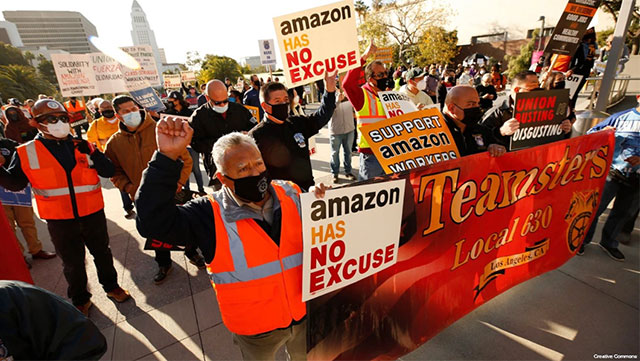
Teamsters in Los Angeles. Turn the tough talk into action. (Photo: Creative Commons)
Going back to their 2016 convention, Teamsters union leaders have made general statements about wanting to organize Amazon. In 2020, the IBT formed a division to oversee organizing at Amazon, headed by Randy Korgan, president of a Teamster local in San Bernardino, California. That is in the heart of the Inland Empire, the corridor along Interstate 10 where endless warehouses stock and deliver goods coming through the ports of Long Beach and Los Angeles. This area should be a ripe target for a massive organizing campaign – a serious struggle starting at a few locations could spread quickly among these heavily immigrant workers, join with the hard-pressed, mainly Latino port truckers and hook up with the powerful ILWU longshore union. If the bosses are worried about the supply chain now, consider what a warehouse-trucker-port strike would do.
On June 24, the IBT national convention passed a “Special Resolution: Building Teamster Power at Amazon.” Citing how Amazon posed “an existential threat to the standards we have set” in UPS, parcel delivery, freight, etc., it vowed that “helping [Amazon] workers achieve a union contract is a top priority” for the Teamsters. Korgan has said that “the NLRB is not the only way” and written that Teamsters have “fought for workers' rights to organize and build power any way we could, including shop floor strikes, city-wide strikes and actions in the streets. Building genuine worker power at Amazon will take shop-floor militancy by Amazon workers and solidarity from warehousing and delivery Teamsters” (Salon, 14 June 2021).
Talking the tough talk has to be put into practice. Organizing Amazon was an issue in the national Teamsters election this fall, in which the ruling Teamster Power faction of the bureaucracy of retiring president James Hoffa Jr. was pitted against the Teamsters United faction, led by Sean O’Brien and Fred Zuckerman, much of whose base came from Teamsters for a Democratic Union (TDU). The history of this grouping is important. The TDU originated in the 1970s and notoriously sued the Teamsters in the capitalist courts in the name of “union democracy,” a betrayal of working-class principle. Having invited the capitalist government in to run the union elections, Ron Carey, a TDU-supported candidate, won the IBT presidency in 1991. But after a strike at UPS in 1997 won, the government ousted Carey. Bring in the feds and they own you.
So the chickens came home to roost, and James Hoffa Jr. led the union for the next 24 years. Now a TDU-backed coalition has won the union election with almost 70% of the vote. A big issue was the rotten 2018 UPS contract agreement, which the Hoffa leadership pushed through even after the membership voted it down. That contract created a new “22.4” job category in which workers were paid less and worked “flexibly” (with ever-changing hours) while keeping part-time workers at poverty-level wages. O’Brien broke with Hoffa Jr. over that contract and UPS workers, notably in the powerhouse Local 804 in New York City, are a key base of support to the TDU. Now the Teamsters are proclaiming a mandate of “militancy.”
But the leadership of the Teamsters, whether Teamster Power or Teamsters United, is not based on militant class struggle. For more than half a century, the entire U.S. labor bureaucracy has been committed to class collaboration – Hoffa Sr. included, although the feds went after him for achieving the first-ever national Master Freight Agreement. While the IBT has had training sessions on engaging Amazon drivers and warehouse workers, a central activity has been lobbying local governments to stop Amazon from building facilities because it treats workers unfairly, causes pollution, etc. This is a worthless strategy: what’s needed to promote workers’ rights and social benefit is to organize Amazon, not look to local capitalist governments to pressure Amazon.
O’Brien and the TDU have said that a key part of their strategy is to show Amazon workers the benefits of a union by fighting for “strong contracts” when the UPS contract expires in 2023 and the DHL contract expires next year. Winning major gains from the shipping bosses won’t come easy – it will take an all-out nationwide strike. But to show Amazon that the Teamsters mean business, solidarity action will be vital. Instructing Teamster drivers to NEVER CROSS PICKET LINES, and to “hot cargo” (refuse to handle) struck goods anywhere will send a clear message to union activists at Amazon that the Teamsters have got their backs.
Organize JFK8 with Class Struggle!
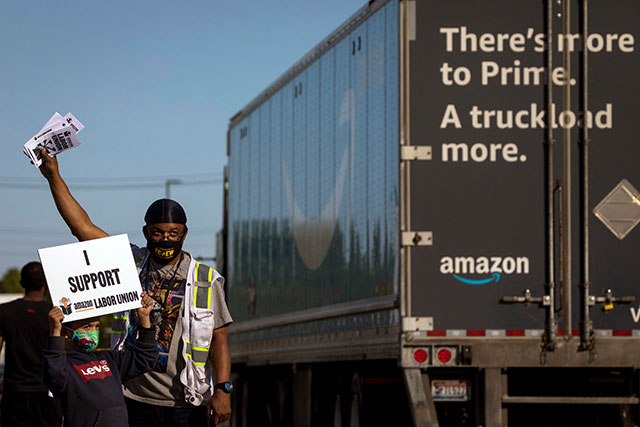
Supporter of Amazon Labor Union and his son leafleting warehouse workers and drivers at JFK8 facility in Staten Island, New York, May 2021. (Photo: Dave Sanders for The New York Times)
Defying defeatist moods that set in after the defeat at Bessemer, an organizing campaign was launched last April at Amazon’s JFK8 warehouse in Staten Island, New York City by activists who formed the Amazon Labor Union (ALU). The ALU asserted it would win because it was “worker-led” and not affiliated with an existing union. However, the ALU’s strategy has been remarkably similar to the RWDSU’s in Bessemer: rapid gathering of authorization cards to meet the NLRB threshold for an election, while holding solidarity rallies and seeking the support of politicians and celebrities. So far only a small number of workers have come out openly as union supporters. In response to the ALU, Amazon followed its Bessemer playbook, churning out anti-union propaganda and holding “captive audience” union-bashing meetings with workers. Pro-union activists have countered the company stooges in those meetings.
The ALU is led by Chris Smalls, who was a supervisor at JFK8 until he was fired in March of 2020 for bravely protesting against the lack of COVID safety protocols in the warehouse. On October 25, the ALU turned in over 2,000 authorization cards at the NLRB office in Brooklyn, declaring its intention to organize not only JFK8 but three smaller Amazon warehouses on Staten Island. The ALU said 5,600 workers work there, Amazon claimed 9,660 workers at those four facilities. On November 12, the ALU withdrew its election petition after the NLRB said that its initial check found almost half the workers who signed authorization cards no longer worked at the warehouse, reflecting the massive turnover. On December 22, now with 3,000 cards in hand, the ALU resubmitted its request for an election vote at JFK8 only.
Smalls has stated that things will be different than in Bessemer, because “New York is a union town.” That is certainly a major factor, but it’s not enough unless NYC unions actively mobilize to aid the organizing drive in Staten Island. At a December 22 Times Square rally, Smalls called for the NLRB to “do the right thing” and “use remedies that go around the 30%” rule – that 30% of the workforce must sign cards to get an election – because the annual turnover rate at JFK8 is 150%.” There should be no illusions in the Labor Board, which was set up in 1935 to enforce government control of unions not to build them. The NLRB is no ally but an enemy of labor. As we have written before, while union activists may have to make use of its procedures:
“Genuine Marxists (i.e., Trotskyists) oppose any mechanisms of government control of labor, whether by card check or NLRB-supervised ‘elections.’ A real union organizing drive would rest on mobilizing the workers’ strength in action, including possible strike action.”
–“Why Marxists Oppose All Government Intervention in the Unions,” The Internationalist No 28, March-April 2009
Co-organizing the Times Square rally was the Workers Assembly Against Racism (WAAR), led by the Workers World Party (WWP). WAAR and WWP have latched onto the ALU effort, promoting rallies outside Bezos’ Manhattan penthouse rather than pushing for class struggle. They call for Amazon to voluntarily “Stop Union Busting! Recognize the Union & Negotiate Now!” Lots of luck with that one. Begging the union-busters to turn into union promoters is a liberal delusion. Similarly, after the defeat in Bessemer, Workers World launched a petition to “Tell Biden to Pass the PRO Act by Executive Order!” Instead of calling to break with the Democrats and oppose government control, this only promoted illusions in Biden and phony “friend of labor” Democrats.2
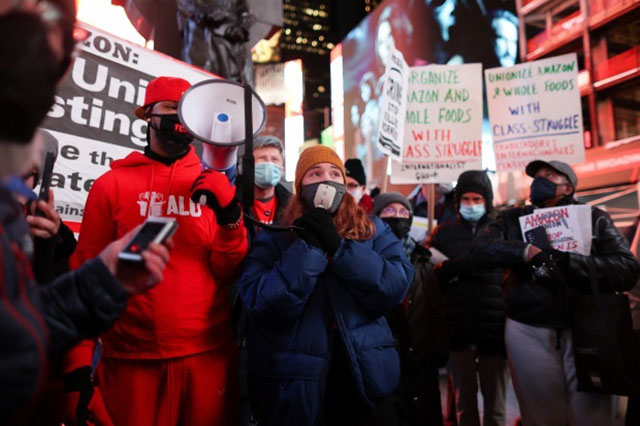
December 22 rally in Times Square after Amazon Labor Union re-filed with the NLRB for a union-recognition election. (Photo: Reuters)
The same day as the rally (December 22), the NLRB announced it had reached a settlement with Amazon on dozens of complaints that had been filed since the start of the pandemic, under which the company would post signs saying that it had violated workers’ right to organize by prohibiting employees from being on the property more than 15 minutes before or after a shift and banning union supporters from advocating in lunchrooms and other non-work areas, as has happened at JFK8, Chicago and elsewhere. Amazon was required to notify all of its employees nationally that they have the right to organize and that Amazon will not interfere with that right. Want to bet on how seriously Amazon will abide by this settlement? And keep in mind that black workers at JFK8 are almost 50% more likely to be fired than white co-workers.3
The key to winning a union at JFK8 and Amazon locations around the country is to build a core of class-struggle unionists in the warehouses and among drivers; to bring out supporters in a show of strength at key moments (Black Friday, Amazon Prime Day, May Day), including in shift-change rallies and job actions building up to walkouts when the union is strong enough to make them real; to raise concrete demands now ($5 an hour raise, union safety committees, slower line speed, longer lunch and bathroom breaks, end cellphone ban and firing by apps, etc.); and to mobilize mass labor solidarity, with hundreds of unionists outside the warehouses. Union supporters must see they are not alone. The bottom line is that a substantial core of committed class-struggle militants must be cohered in order to win broad backing for the union in action rather than relying on the bosses’ government.
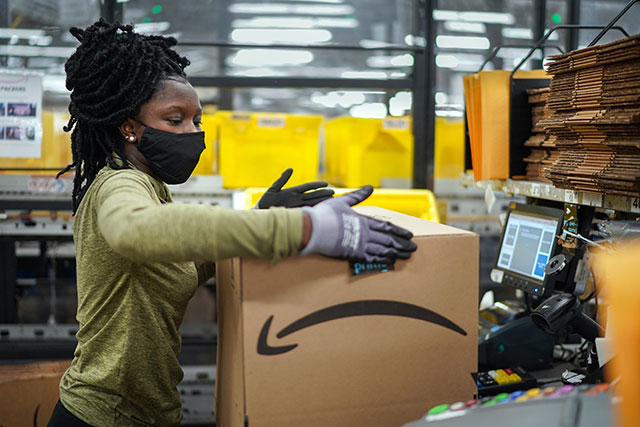
Worker at JFK8. Speed-up causes injuries. For workers safety committees with the power to shut it down. (Photo: Chang W. Lee / New York Times)
What Does Class Struggle Unionism Look Like?
Also on December 22, about 70 workers Amazon workers at two delivery stations in Chicago and Cicero, Illinois walked off the job demanding raises, longer breaks and better staffing to reduce overwork. These workers are led by Amazonians United, which also carried out a walkout last April in response to the implementation of brutal “megacycle” shifts. That walkout won a $2 shift differential for that shift. Such job actions show it is possible to struggle against Amazon. They raise the need for the kind of militant actions that built the unions in the 1930s.
The organizing drives that created the industrial unions were not won in government-run elections. The mass, militant 1934 Minneapolis strikes that forged the Teamsters were led by Trotskyists, who stopped scab trucking with flying picket squads and ran off sheriff’s deputies and auxiliaries in the streets. They then used these militant tactics to organize Midwest over-the-road truckers and unemployed workers in Minnesota. Also in 1934, the ILWU established its hold in the West Coast longshore and warehouse industry as a result of the San Francisco general strike, also led by “reds.” The great Flint, Michigan sit-down strike of 1936-37 was won by occupying the GM plants, fighting off an attempt by city cops to retake the key plant in the “Battle of Running Bulls,” and seizing an additional plant with the aid of an Emergency Brigade formed by the Women’s Auxiliary, led by a Trotskyist activist.
These battles paved the way for the founding of the Congress of Industrial Organizations (CIO), large-scale unionization of key industries and the consolidation of the union shop. Yet even then, the leaders of the CIO, including the reformist Communist Party, hitched the unions to the New Deal coalition of Democratic president Franklin Roosevelt. And a decade later, in the late 1940s, the Democratic Party spearheaded the “red purge” that expelled communists from most of the labor movement. Then and now, what was and is needed is to break with the Democrats and build a workers party to fight for a workers government! Class struggle independent of the bosses isn’t just a nice idea: it’s the only way workers can fight back effectively and win, at Amazon and everywhere. ■
- 1. See “No to the Democratic Party of Amazon (and Silicon Valley and Wall Street),” The Internationalist No. 63, January-March 2021.
- 2. The “Protect the Right to Organize” Act passed the House of Representatives but hasn’t got a chance in hell in the Senate. It is a sop to keep liberals and labor tied to the Democrats. While the PRO Act would repeal some notorious anti-labor provisions of the 1948 Taft-Hartley Act of 1948, it maintains the framework of government control of unions, including compulsory arbitration on first contracts of new unions, which would surely include a “no-strike” clause.
- 3. See “The Amazon That Customers Don’t See,” New York Times, 15 June, which notes that the multiracial workforce in the warehouse is mostly African American and Latino while management is overwhelmingly white.